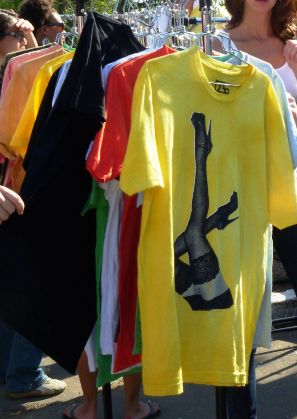Heat Press Styles for Making T-Shirts

Heat Presses & Image Artwork
T-shirt Heat Press Basics
If you are looking to make t-shirts in-house using a heat press, there are many different brands and styles to choose from. A heat press is a mechanical hot plate that is used for making t-shirts and other things by pressing down onto a garment for a period of time to set an image. Then it is lifted up to reveal the image heat set permanently onto the garment itself. They are much more reliable and much quicker than using an iron. They produce even products that have a professional look to them. And some transfer materials only work with a commercial-style heat press since a particular temperature may be needed and can be adjusted, as well some materials may have a pressure requirement.
Materials Used for Making the Artwork
T-shirt designers use a variety of materials for their garment images. Each uses a professional heat press to professionally set the art on the fabric. A standard home iron will not get hot enought to professionally set the materials, and in some cases, it is necessary to press for up to 45 seconds on a specific heat, over the entire image, for it to handle wear and repeated washings.
There are several different types of mediums for the artwork for graphic designs. Here are most popular:
- Vinyl: This comes in rolls, and produces a smooth feel for the t-shirt. Many different colors and patterns are available, and can be purchased with a matte look or very shiny look to the material. These are great for line art, graphical designs like clip artwork, and text.
- Flock: This is the stuff that traditional varsity and sports uniforms have. Images and text using a hotflock material have a velvet, almost three-dimensional feel, to them. Products made with this material may cost more due to the cost in materials.
- Heat Transfer: These are the 'iron-on' images. You can make them yourself at home, but using professional heat transfer paper and a professional heat press machine will set the images better, and last longer. These work by actually heat pressing the digital images directly onto the t-shirt fabric. These will soften with washing, and results in incredible detailing.
- Screen Printing: This is what the 'Yudu' machine for home work does. For professionals, they use actual silkscreen with the images set onto it. When the fabric paint is pressed through the screen, only the image left open on the silkscreen will come through. A very common type of t-shirt making.
- Spray Print: Spray printing uses a compressed air gun with fabric paints. With this set up, you spray out different designs by hand, or use any stencil you want. This type of work is great for layered work, and since there are so many options for the fabric paint (metallics, pearlescent, transparent, and opaque), there are many ways you can do artwork.
T-Shirt Heat Press Styles
Finding a heat press style that fits your needs basically comes down to several key points:
- Size
Find a heat press that will work with the size of t-shirt you'll be making. Generally, a 15 inch by 15 inch press will take care of most sizes for men and women. These include both portrait and landscape designs. Smaller sizes are perfect for children's sizes and for odd placement of the heat pressed images, where a standard square plate will not accommodate. Heat presses also come in very large sizes to accommodate larger fabrics. - Swing Away
These are the most handy. The style is set up as the name suggests - that the top part actually swings AWAY from the t-shirt after it is done. Other styles simply have a top that presses down on the t-shirt and the t-shirt is removed when it is done. The advantage of a swing away style is that you are able to remove the t-shirt more easily if it is bunched up at one end for advanced placements and that your fingers will not get burned by simply lifting up on the bottom plate. - Adjustable Pressure
Heat presses with an adjustable pressure can be adjusted for individual shirt weights and for transfer materials. On some models there is a screw that either can be tightened down or loosened so that when the top part of the heat press is clamped down, the top is either pressed down very hard or softly on top of the t-shirt. - Removable Bottom Plates
These are handy when garments include odd or bulky items such as zippers or heavy seams. The bottom part can be removed or adjusted to fit whatever garment or sized t-shirt is being placed into the heat press. Bottom heat press plates include those for buttons, zippers, snaps, etc. - Adjustable Temperatures
No matter what style of heat press is out there, they all generally come with an adjustable temperature regulator. This is very important when working with different substrates. Different fabrics may require a higher or lower temperature. Different transfer materials such as polyurethane vinyl or heat press image transfers may also require different heat temperature ranges in order to set them properly on the garment.








